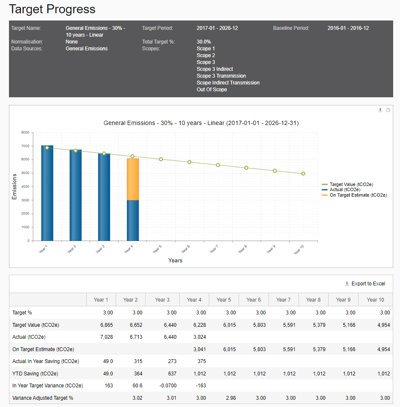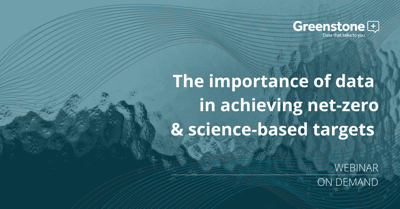Science-based targets and net-zero commitments - FAQs
 Climate Week NYC 2020 was held last month and this year’s edition was certainly one to remember. Not only was it held entirely online, but the week of events included ambitious commitments from some of the biggest names. Most notably, the University of Cambridge announced a net-zero target by 2038, Facebook committed to a net-zero target by 2030 and Walmart, the world’s largest company, outlined plans to be 100% carbon neutral by 2040 (without using carbon offsets).
Climate Week NYC 2020 was held last month and this year’s edition was certainly one to remember. Not only was it held entirely online, but the week of events included ambitious commitments from some of the biggest names. Most notably, the University of Cambridge announced a net-zero target by 2038, Facebook committed to a net-zero target by 2030 and Walmart, the world’s largest company, outlined plans to be 100% carbon neutral by 2040 (without using carbon offsets).
With a noticeable increase in corporate targets and commitments, comes a barrage of terms and definitions that are often used interchangeably. To help you understand key terms and definitions related to science-based and net-zero targets, the team at Greenstone has prepared some answers to some of the most frequently asked questions:
What does net-zero mean?
The IPCC describes net-zero as “that point when anthropogenic emissions of greenhouse gases to the atmosphere are balanced by anthropogenic removals over a specified period”. This means a company’s emissions output must be balanced with the removal of carbon (to equal net zero).
Practically, if a business emits a certain amount of tCO2e/per year, to become ‘net-zero’ it will first need to reduce its value-chain emissions through initiatives such as switching to renewable energy, limiting business travel or considering cleaner technologies. Then, for the unavoidable emissions, the business can look to carbon removal initiatives, or offsets, to offset the residual emissions in order to reach net-zero.
Is there a difference between net-zero and carbon neutrality?
Often, carbon neutrality is used as a synonym for net-zero, but there is a slight difference between the two terms.
Carbon neutrality refers to the act of offsetting residual emissions or compensating current emissions. A market has developed around carbon neutrality as businesses can buy “carbon credits”, where they invest in projects that will avoid, reduce or capture carbon (e.g. renewable energies and forest protection).
Net Zero is henceforth the wider goal, where no GHG emissions are added to the atmosphere through the maximum reduction of emissions and the offsetting of residual emissions.
What are science-based targets (SBTs)?
SBTs are born out of a partnership between CDP, the UN Global Compact, The World Resources Institute, WWF and We Mean Business as a method for organisations and businesses to set reduction targets for their carbon emissions in line with the Paris Agreement. They are backed by current scientific knowledge and provide reductions pathways aligned with the goal of limiting global warming to well below 2 degrees and as close to 1.5 degrees as possible. In other words, we can think of them as the National Determined Contributions (which are emissions reduction goals that countries had to commit to as a result of the Paris Agreement) but at a corporate level.
What does science tell us?
According to the IPCC Special Report on the impacts of global warming of 1.5 degrees (2018), “limiting warming to 1.5 degrees implies reaching net-zero CO2 emissions globally around 2050”. The IEA also demonstrates in its Sustainable Development Scenario that if we reach net-zero emissions in 2070, we will have a 66% chance of limiting the global temperature average rise to 1.8 degrees. Needless to say that the stakes are high.
How do science-based targets differ or relate to net-zero targets?
First of all, SBTs and NZTs are not mutually exclusive but complementary. Indeed, in order to reach Net Zero, it is recommended that organisations use SBTs emissions reduction targets. In other words, NZTs are the goal and SBTs are the method (complemented by carbon offsetting, compensation or capture). Below are some comparisons:
Validation:
- SBTs are much stricter than any other target setting as they require to be validated by the SBT Initiative within 2 years of committing to them and also entail a validation price. They are regulated by a rigorous process in order to assure their correct deliverance.
- NZTs are not part of a wider framework and are therefore not regulated nor verified.
Timeframe:
- SBTs are known to be shorter-term targets (5-15 years). One explanation is notably the fact that setting short and constraining targets can lead to greater results and faster action.
- NZTs are set on a much longer-term (15+ years) as part of a global sustainability strategy.
Scopes:
- As a consequence of their rigorous framework, SBTs must include reductions for Scopes 1 & 2, which are within the organisation’s boundary but also Scope 3 emissions, which are often the source of major emissions within an entity’s value chain.
- Net-Zero emissions do not require an organisation to include scope 3 emissions within the scope of their reductions.
Why should a business set a science-based target?
- Climate leadership: With the ever-increasing sustainability demand and expectation from stakeholders, setting a SBT will improve brand reputation and attract employees, consumers and investors.
- Emissions analysis: By calculating and analysing emissions during the target setting process, organisations will be able to identify hotspots and implement reduction initiatives.
- Supply chain visibility: SBTi requires the assessment and improvement of Scope 3 emissions, providing organisations with greater insights on their entire value chain impact.
- Performance transparency: Reporting on progress against an approved SBT will widen the scope of sustainability disclosures, increasing investor and general stakeholder transparency.
- Sustainability reporting: With SBTs expected to become the recognised industry best practice, setting an approved target will ensure that businesses keep ahead of a constantly evolving sustainability reporting and regulatory landscape.
Tracking targets in Greenstone's sustainability reporting software
Greenstone’s latest sustainability reporting software release included a new and enhanced Targets functionality in the Environment module. Aligned with the requirements of SBTi, organisations can set and track performance against flexible and long-term environmental consumption and GHG targets. To find out more about how Greenstone’s award-winning sustainability reporting software can help you achieve your sustainability goals, please talk to us.

Key documents and references
- “Foundations for science-based net-zero target setting in the corporate sector” Publication by The Science Based Targets Initiative and CDP
- “Financial sector science-based targets guidance” Publication by The Science Based Targets Initiative and CDP
- Greenstone & Science-based targets
On-Demand Webinar | The importance of data in achieving net-zero & science-based targets










